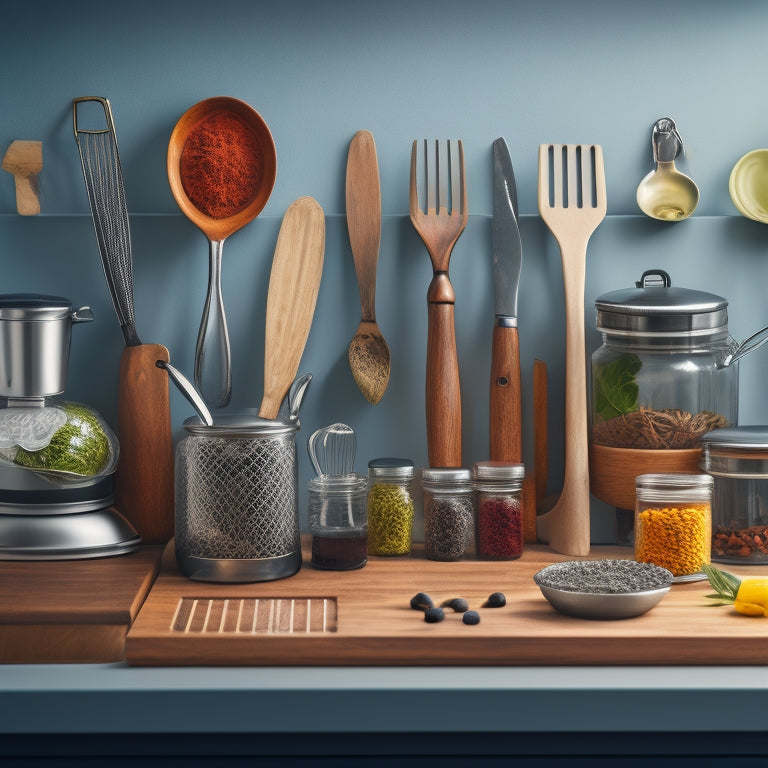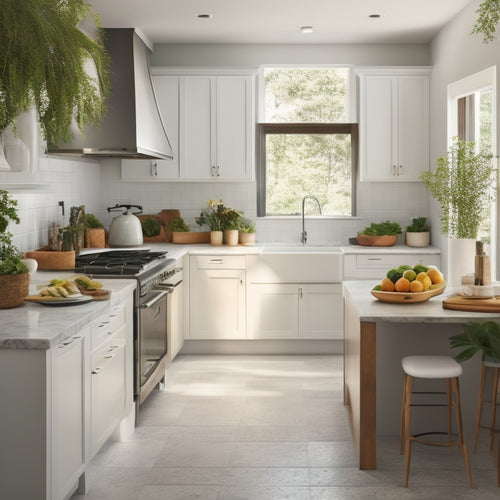
Optimize Your Kitchen: 5 Essential Utensil Organization Tips
Share
You're about to transform your kitchen into a well-oiled machine! Start by purging and categorizing your utensils, grouping similar items together for easier access. Assign a home for each item, using labels and containers to keep things tidy. Maximize your vertical storage spaces with hooks and baskets, and designate a drawer for utensils, using dividers to separate them by type or frequency of use. Keep your most-used items accessible, positioning them in front of the drawer or in a nearby container. By implementing these essential organization tips, you'll be cooking up a storm in no time - and that's just the beginning!
Key Takeaways
• Assess and categorize utensils by function, grouping similar items together for easy access and organized storage.
• Assign a home for each item, using labels, containers, and dividers to maintain organization and visual appeal.
• Maximize vertical storage spaces by using wall hooks, hanging baskets, and utensil caddies to minimize clutter.
• Designate a central hub drawer for utensils, using dividers and inserts to separate items by type and frequency of use.
• Position frequently used utensils in easy-to-reach locations, such as countertops or front-of-drawer storage, to streamline cooking.
Purge and Categorize Utensils First
Before you can arrange your utensils efficiently, ask yourself: what utensils do you really need and use regularly, and which ones are simply taking up valuable space in your kitchen? Be honest – if you haven't used it in the past year, it's probably safe to let it go. Sort and donate any unnecessary or duplicate items, freeing up space and reducing clutter.
Next, categorize your remaining utensils by function. Group similar items together, such as baking utensils, cooking utensils, and serving utensils. This will make it easier to see what you have and where it should go. Organize by function, not by type, to make certain that you're storing utensils in a way that makes sense for your cooking habits.
For example, store all your baking utensils near your mixing station, and your cooking utensils near the stovetop. By purging and categorizing your utensils, you'll be able to see what you have, what you need, and where everything should go – making it easier to maintain your kitchen's organization.
Assign a Home for Each Item
With your utensils purged and categorized, now it's time to assign a specific location for each item, ensuring that everything has a designated spot where it can be easily accessed and returned. This is where a labeling system comes in handy.
Create labels for each category, such as 'Baking' or 'Cooking,' and assign a specific container or drawer for each group. Within those containers, use organizing containers or dividers to separate individual items, like spatulas from whisks.
Consider color coding your labels or containers to create a visually appealing system that's easy to navigate. For smaller items like measuring spoons or magnetic strips, designate a specific spot, such as a magnetic board or a small tray, to keep them organized and within reach.
Utilize Vertical Storage Spaces
You can maximize your kitchen's storage potential by exploiting often-wasted vertical spaces, such as the backs of cabinet doors or walls, to store infrequently used utensils and free up valuable counter and drawer space. By doing so, you'll create a more efficient kitchen that's easy to navigate.
Install wall hooks to hang items like pots, pans, utensils, and even aprons. This won't only keep them organized but also add a decorative touch to your kitchen.
You can also use hanging baskets to store items like spices, oils, or snacks. These baskets can be easily mounted on walls or the back of a cabinet door, providing easy access to the items you need.
Remember to choose the right type of hooks and baskets that fit your kitchen's style and the items you want to store.
With a little creativity, you can turn wasted vertical space into a functional storage area that streamlines your kitchen workflow. By utilizing vertical storage spaces, you'll be able to focus on cooking and enjoying your time in the kitchen, rather than wasting time searching for misplaced utensils.
Designate a Drawer for Utensils
Assign a specific drawer in your kitchen to serve as a central hub for utensils, keeping frequently used items like whisks, spatulas, and wooden spoons within easy reach. This designated drawer will streamline your cooking process and reduce clutter in your kitchen.
To maximize the efficiency of your utensil drawer, consider the following strategies:
-
Use drawer dividers to separate utensils by type or frequency of use, ensuring that you can quickly find what you need.
-
Install utensil caddies or inserts to keep utensils organized and prevent them from getting jumbled together.
-
Implement a 'first in, first out' policy for your utensils, ensuring that the most frequently used items are at the front of the drawer and easily accessible.
Keep Frequently Used Items Accessible
Position your most frequently used utensils in the front of the drawer or in a nearby container, ensuring they're always within easy grasp when you need them. This simple trick will save you time and effort in the long run. By keeping your go-to utensils accessible, you'll avoid digging through a cluttered drawer or cabinet to find what you need. This, in turn, will help you maximize space and minimize clutter in your kitchen.
Next, consider a utensil organizer or divider to keep frequently used items separate from less-used ones. This will prevent a jumbled mess from forming and make it easier to find what you need at a glance.
You can also use a countertop utensil holder to keep essential items, like your favorite chef's knife or tongs, within easy reach. By keeping your most-used utensils accessible and organized, you'll streamline your cooking process and reduce stress in the kitchen.
Frequently Asked Questions
How Often Should I Clean My Utensil Organizers to Prevent Bacterial Growth?
"Like a ticking time bomb, dirty utensil organizers can harbor bacterial growth, waiting to sabotage your next meal. You should clean them every 1-2 weeks, or daily if you notice buildup, to prevent bacterial growth and keep your kitchen safe and sanitary."
Can I Use Adhesive Hooks to Hang Utensils on a Tile Backsplash?
You can use adhesive hooks to hang utensils on a tile backsplash, maximizing kitchen storage in small spaces, but make sure the hooks are specifically designed for tile and can hold the utensil weight.
What Are Some Eco-Friendly Utensil Storage Materials I Can Use?
You're on the hunt for eco-friendly utensil storage, and you're in luck! Consider swapping traditional materials for sustainable alternatives like bamboo racks or recycled plastic bins, which will not only organize your kitchen but also clear your conscience.
How Do I Organize Utensils With Different Handle Lengths and Sizes?
You'll masterfully organize utensils with varying handle lengths and sizes by implementing adjustable drawer dividers and hanging solutions, ensuring a tailored fit for each item and maximizing your kitchen's storage capacity.
Are There Any Utensil Organizers Suitable for Kitchens With Limited Counter Space?
You're not alone in your kitchen conundrum: 60% of homeowners struggle with cluttered countertops. For kitchens with limited space, you'll find solace in wall-mounted racks that maximize vertical storage or clever drawer dividers that keep utensils tidy and within reach.
Related Posts
-

Mastering Closet Organization With Digital Tools
You're ready to tame the chaos in your closet, and digital tools are here to help. Start by accessing online tutorial...
-

Clear Digital Clutter for a Peaceful Mind
You're tired of feeling anxious and mentally fatigued, but do you know that your cluttered digital space is a major c...
-

Island With Built-In Pot and Pan Organizer
You're likely no stranger to the frustration of cluttered pots and pans taking over your kitchen, and that's why you'...


